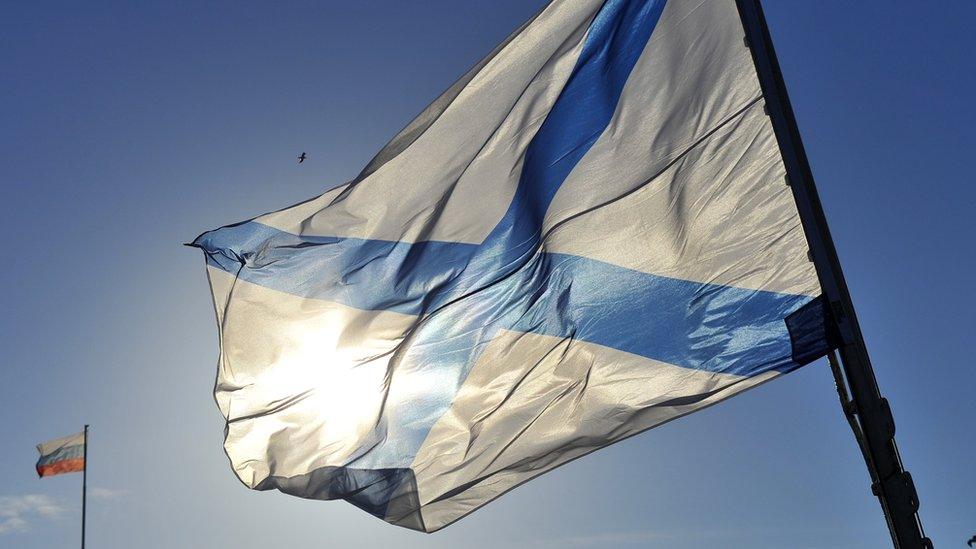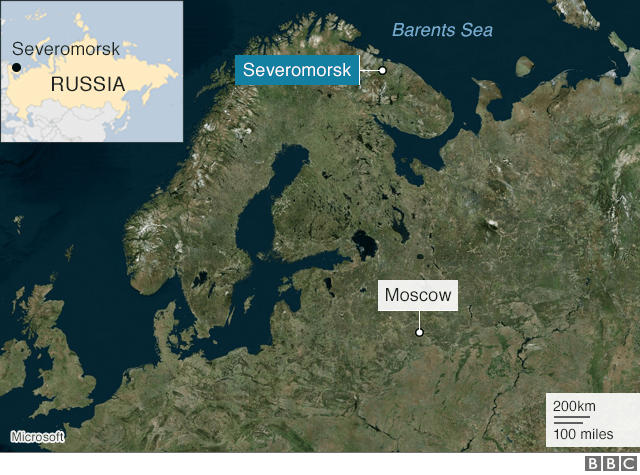Russia: Fire kills 14 sailors aboard navy research submersible
- Published

Severomorsk is the main base of Russia's Northern Fleet
A fire aboard a Russian navy research submersible has killed 14 crew members, the Russian defence ministry says.
The crew was poisoned by fumes as the vessel was taking measurements in Russian territorial waters on Monday.
The ministry gave no details about the type of vessel. But Russian media reports say it was a nuclear mini-submarine used for special operations.
The fire was later put out and the vessel is now at Severomorsk, the main base of the Russian Northern Fleet.
Allow X content?
This article contains content provided by X. We ask for your permission before anything is loaded, as they may be using cookies and other technologies. You may want to read X’s cookie policy, external and privacy policy, external before accepting. To view this content choose ‘accept and continue’.
The defence ministry did not say how many crew members were aboard at the time. Reports in local media say several crew were injured and taken to hospital.
An investigation into the incident has begun under the commander-in-chief of the navy.
Russian President Vladimir Putin later on Tuesday pulled out of a scheduled event in the Tver region, north-west of Moscow, to discuss the issue with Defence Minister Sergei Shoigu.
Mr Putin described the incident as a big loss for the Russian Navy, and expressed "sincere condolences" to the victims' families.
Seven captains and two service personnel awarded Russia's highest honorary title, Hero of the Russian Federation, were among those who died on board the vessel, the president said.
Mr Shoigu was ordered to go immediately to Severomorsk.


It's still not clear what caused the fire, which the crew ultimately brought under control; we don't know how many men survived.
And there are still questions over exactly what vessel was involved.
President Putin said the dead included two heroes of Russia and seven "captains 1st rank"- which seems unusually senior - for research work.
Some media in Russia are citing sources saying they could have been on board a nuclear-powered submarine, possibly even the secretive AS-12. It is thought to be used for highly sensitive missions.
Mr Putin returned especially to the Kremlin from out of town to order his defence minister to oversee the investigation.
The president is clearly keen not to repeat his disastrous handling of the Kursk submarine disaster in August 2000, when 118 men died.
That accident was shrouded in secrecy - and Mr Putin initially stayed on holiday for several days.

Submersibles are generally smaller vessels with limited crew on board supported by ships on the surface, while submarines are larger vessels capable of operating autonomously over long distances.
The Kursk submarine, which was destroyed by the blasts in the Barents Sea, was also part of the Northern Fleet.


Underwater tragedies
Accidents involving underwater vessels are rare. Here are some of the most serious:
The Argentine navy's ARA San Juan submarine with 44 crew disappeared during a routine patrol in the South Atlantic in 2017. The wreckage was found a year later
All 70 crew aboard China's Great Wall Ming-class submarine suffocated in 2003 when a diesel engine malfunctioned, consuming the vessel's oxygen supply
Russia's Kursk submarine sank in the Barents Sea in 2000 after a torpedo exploded during an exercise, killing all 118 on board, including 23 who survived the blast but died due to a lack of oxygen
The USS Scorpion sank in the Atlantic in 1968, possibly because a torpedo exploded, killing the 99 crew
The USS Thresher sank during diving tests in 1963, killing all 129 on board - the biggest submarine death toll in history
